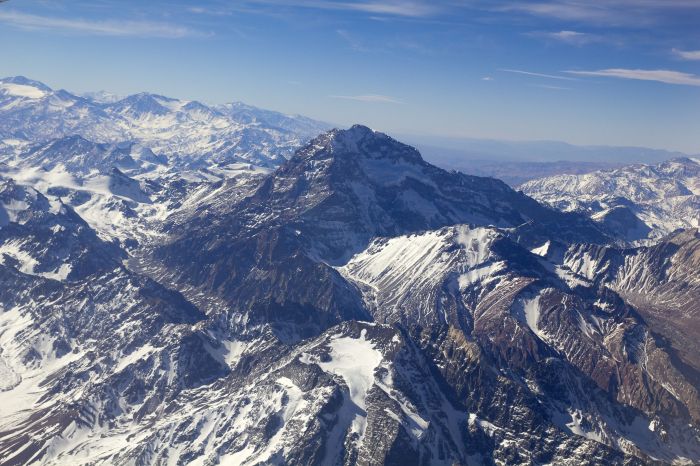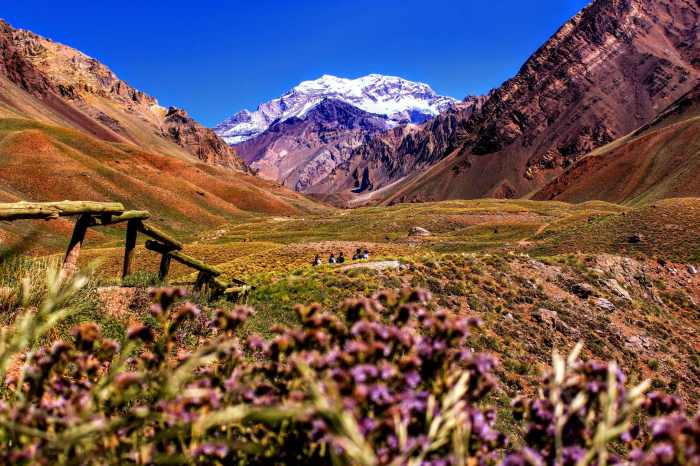Aconcagua, the towering sentinel of the Andes, stands as the highest peak in the Americas, beckoning adventurers and nature enthusiasts alike. With its majestic summit piercing the heavens, Aconcagua’s allure lies in its breathtaking landscapes, diverse ecosystems, and rich cultural heritage.
From its formidable slopes to its icy glaciers, Aconcagua offers a captivating tapestry of natural wonders. Its geological history, ecological significance, and cultural importance make it a captivating subject for exploration.
Physical Characteristics

Aconcagua stands as a colossal sentinel in the heart of the Andes, towering over the surrounding landscape with an elevation of 6,961 meters (22,838 feet) above sea level. Its prominence, the vertical distance between its summit and the highest saddle connecting it to a higher peak, is a staggering 6,961 meters, making it the most prominent peak in the Western and Southern Hemispheres.
The topography of Aconcagua is a testament to the relentless forces of nature that have shaped it over millions of years. Its slopes are adorned with an array of peaks, glaciers, and valleys that create a breathtaking and challenging landscape for mountaineers. The highest peak, known as the Southern Summit, is the ultimate goal for climbers, while the Northern Summit, slightly lower in elevation, offers a formidable alternative route to the top.
Geological Composition and Formation
Aconcagua’s geological composition is a complex tapestry of rock formations that reveal the mountain’s long and dynamic history. The core of the mountain is composed of igneous and metamorphic rocks, formed from the solidification of molten magma and the transformation of existing rocks under intense heat and pressure. These rocks have been uplifted and exposed by the relentless forces of plate tectonics, creating the towering peaks and rugged terrain that characterize Aconcagua today.
Ecological Significance
Aconcagua’s diverse ecosystem supports a wide range of flora and fauna. Its slopes are home to over 250 species of plants, including wildflowers, shrubs, and trees. The mountain also provides habitat for a variety of animals, including guanacos, vicuñas, condors, and pumas.
Importance as a Habitat for Endangered Species
Aconcagua is a crucial habitat for several endangered species, including the Andean condor and the vicuña. The condor is the largest flying bird in the world and is found only in the Andes Mountains. The vicuña is a small camelid that is prized for its fine wool. Both species are threatened by habitat loss and hunting.
While Aconcagua, the colossal mountain in Argentina, beckons adventurous spirits, its cultural tapestry is equally captivating. Just as diverse as the world’s best cultural festivals worldwide , the traditions of Aconcagua’s indigenous communities and vibrant cities offer a kaleidoscope of customs, rituals, and celebrations that reflect the rich heritage of this stunning region.
Impact of Human Activity
Human activity has had a significant impact on the ecosystem of Aconcagua. The mountain is a popular destination for climbers and tourists, and this has led to increased pollution and disturbance of the environment. Climate change is also having an impact on Aconcagua, with rising temperatures causing the glaciers to recede.
Aconcagua, the highest mountain outside Asia, is a sight to behold. Its grandeur is unmatched, and it’s a popular destination for mountaineers and hikers alike. However, if you’re looking for a more cultural experience, consider attending one of the best cultural festivals worldwide.
These festivals offer a unique opportunity to learn about different cultures and traditions, and they’re a great way to experience the local flavor. After a day of exploring Aconcagua, relax and enjoy the vibrant atmosphere of a cultural festival.
Historical Significance
Aconcagua’s towering presence has captivated explorers and mountaineers for centuries. Its exploration and conquest have played a significant role in the history of mountaineering and the cultural heritage of the region.
Timeline of Notable Expeditions and Ascents:
- 1883: Swiss-Austrian expedition led by Paul Güssfeldt makes the first recorded attempt to climb Aconcagua, reaching an altitude of 6,500 meters.
- 1897: British expedition led by Edward Fitzgerald makes the first successful ascent of Aconcagua via the Normal Route.
- 1934: Polish expedition led by Stefan Osiecki makes the first winter ascent of Aconcagua.
- 1953: French expedition led by Lionel Terray makes the first ascent of Aconcagua via the South Face.
- 1981: Polish climber Krzysztof Wielicki makes the first solo ascent of Aconcagua.
Cultural and Historical Importance to Indigenous People
Aconcagua holds immense cultural and spiritual significance for the indigenous people of the region, particularly the Inca and Mapuche. They believed the mountain to be sacred, a dwelling place for gods and spirits. The Inca revered Aconcagua as the “Mountain of the Sun” and made pilgrimages to its base.
Anecdotes and Stories
Aconcagua’s exploration and conquest have inspired numerous anecdotes and stories. One famous tale involves the Swiss-Austrian expedition of 1883. During their ascent, they encountered a group of local Indians who offered them coca leaves to help them acclimatize to the altitude. The expedition members declined, believing the leaves to be harmful. However, after several days of struggling with altitude sickness, they decided to try the coca leaves and found immediate relief.
Tourism and Recreation: Aconcagua
Aconcagua is a popular destination for mountaineering and trekking, attracting adventurers from around the world. There are several established routes to the summit, each with its own challenges and rewards.
Aconcagua, the highest peak in the Americas, stands as a majestic symbol of adventure and wilderness. Its towering presence invites travelers to embark on an unforgettable journey. As the world becomes increasingly aware of the importance of sustainable practices, Aconcagua offers an opportunity to explore the natural beauty of this region while minimizing our environmental impact.
Sustainable travel destinations prioritize conservation and community engagement, ensuring that future generations can continue to marvel at the grandeur of Aconcagua.
The most popular route is the Normal Route, which ascends the mountain’s northwest ridge. This route is considered technically straightforward but requires a high level of fitness and acclimatization due to the altitude. Other popular routes include the Polish Glacier Traverse, the Guanaco Glacier Route, and the South Face Route, which offer more technical challenges.
Infrastructure and Support Services
There is a well-established infrastructure in place to support climbers and trekkers on Aconcagua. Several mountain huts and camps provide accommodation and basic amenities along the popular routes. Park rangers and guides are also available to assist climbers and ensure their safety.
Challenges and Risks
Climbing Aconcagua is a challenging and potentially dangerous undertaking. The altitude, extreme weather conditions, and rugged terrain can pose significant risks to climbers. Altitude sickness, hypothermia, and frostbite are common hazards. Climbers must be well-prepared, properly equipped, and have a high level of mountaineering experience to attempt the summit.
Environmental Issues

Aconcagua, like many natural wonders, faces various environmental challenges. These include pollution, climate change, and waste management. However, measures are being taken to protect and preserve the mountain’s environment.
Pollution, primarily from human activities, poses a significant threat to Aconcagua. The mountain’s remote location makes it susceptible to air and water pollution from distant sources, including industrial emissions and vehicle exhaust.
Climate Change
Climate change is another major concern for Aconcagua. Rising temperatures and changes in precipitation patterns have led to the retreat of glaciers and the loss of biodiversity.
Waste Management
Waste management is a challenge on Aconcagua due to the high volume of visitors. Improper waste disposal can contaminate water sources and damage the ecosystem. Measures are being taken to address this issue, such as waste collection and recycling programs.
Ecotourism, Aconcagua
Ecotourism plays a crucial role in sustainable development around Aconcagua. By promoting responsible tourism practices, ecotourism helps to minimize the environmental impact of visitors and supports local communities.
Cultural Significance

Aconcagua holds profound cultural significance for the people of Argentina and Chile, serving as a symbol of national pride, adventure, and natural heritage. The mountain’s towering presence has inspired countless works of art, literature, and folklore, and it remains a popular destination for climbers and nature enthusiasts alike.
Role in Literature, Art, and Folklore
Aconcagua has been immortalized in the writings of famous authors, including the Argentine writer Jorge Luis Borges, who described it as “the high, desolate kingdom of stone and snow.” Artists have also been drawn to the mountain’s majestic beauty, capturing its essence in paintings, sculptures, and photographs. In Chilean folklore, Aconcagua is often depicted as a sacred place inhabited by spirits and deities.
Cultural Events and Festivals
Aconcagua is celebrated through various cultural events and festivals. The “Fiesta Nacional del Montañismo” (National Mountaineering Festival) is held annually in Mendoza, Argentina, and features exhibitions, conferences, and climbing competitions. In Chile, the “Festival Internacional de Montaña” (International Mountain Festival) is held in the Aconcagua Valley, showcasing mountain culture, music, and adventure sports.
Scientific Research

Aconcagua serves as a natural laboratory for scientific investigations due to its diverse ecosystems, extreme conditions, and unique geological features. Research conducted on the mountain has contributed significantly to our understanding of climate change, geology, and ecology.
Climate Research
Aconcagua’s elevation and proximity to the Pacific Ocean create a unique microclimate that is ideal for studying climate change. Researchers have established weather stations and monitoring systems on the mountain to collect data on temperature, precipitation, and wind patterns. This data has provided insights into the impacts of climate change on high-altitude environments and the role of the mountain in regional weather systems.
Geology Research
The mountain’s complex geological history has made it a valuable site for geological research. Studies have examined the formation and evolution of the Andes Mountains, the composition of the mountain’s rocks, and the role of tectonic forces in shaping the landscape. These investigations have contributed to our understanding of mountain building processes and the geological history of the region.
Ecology Research
Aconcagua’s diverse ecosystems, ranging from arid desert to high-altitude glaciers, provide a rich environment for ecological research. Scientists have studied the adaptations of plants and animals to extreme conditions, the dynamics of food webs, and the impacts of human activity on the mountain’s ecosystems. This research has helped us understand the resilience of high-altitude ecosystems and the importance of protecting these fragile environments.
Final Wrap-Up
Aconcagua, a symbol of resilience and beauty, continues to inspire awe and wonder. Its towering presence serves as a reminder of the power and fragility of our planet, urging us to protect and preserve this natural treasure for generations to come.
Commonly Asked Questions
How high is Aconcagua?
Aconcagua stands at an elevation of 6,961 meters (22,838 feet) above sea level.
What is the best time to climb Aconcagua?
The optimal climbing season for Aconcagua is from December to February, when the weather is generally more stable and favorable.
Is it difficult to climb Aconcagua?
Climbing Aconcagua is a challenging endeavor that requires physical fitness, acclimatization, and proper preparation. The altitude and weather conditions can pose significant risks.